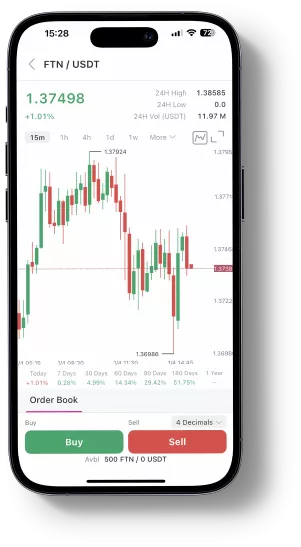
How to Diversify Your Crypto Portfolio?
Building a good crypto portfolio is critical when going through market ups and downs. And by "good" we mean "diverse." It takes a great amount of planning and assessment to generate profits from your investments. In this article, you'll learn strategies and insights on how to diversify your crypto portfolio.
We start by breaking down the different types of cryptocurrencies - from the well-established to the emerging players - and explain how each can play a role in your investment strategy. This guide is packed with practical advice on balancing your portfolio, whether you're aiming for stability with large-cap cryptos or seeking growth opportunities in altcoins and tokens..
What is a Crypto Portfolio?
A crypto portfolio is a collection of different cryptocurrencies an individual or entity holds as part of their investment strategy. It represents the totality of their crypto assets, containing various digital currencies such as Bitcoin and Ethereum, altcoins like Fasttoken, stablecoins, and utility tokens. Each asset in the portfolio contributes to the investor's overall financial goals, risk tolerance, and investment strategy. The composition of a crypto portfolio alters depending on the investor's objectives, market analysis, and response to the dynamic nature of the cryptocurrency market. Managing a crypto portfolio involves regular assessment, rebalancing, and adjustment in line with market movements and personal investment goals.
Types of cryptocurrencies
When thinking of composing your crypto portfolio, it is essential to recognize different types of crypto coins, that can constitute the balance and success of your financial goals. Let’s have a look at the list of the widespread types of crypto that exist:
- Bitcoin (BTC): The pioneer of cryptocurrencies, Bitcoin is recognized as a digital store of value and a medium for peer-to-peer transactions. It operates on a decentralized blockchain and is known for its transparency and security. Often likened to "digital gold," BTC serves as a censorship-resistant store of value and a medium of exchange.
- Altcoins: This category includes a diverse range of cryptocurrencies other than Bitcoin, such as Litecoin (LTC), Fasttoken (FTN), and others. Each altcoin presents distinct features and growth potential.
- Stablecoins: These are digital currencies designed to maintain a stable value, often pegged to traditional assets like fiat currencies. Examples include USDT and USDC.
- Utility Tokens: These tokens serve specific purposes within a project or ecosystem, such as in-game currencies, loyalty rewards, or participation in decentralized governance through voting in Decentralized Autonomous Organizations (DAOs).
- Security Tokens: Representing ownership of real-world assets like stocks or real estate, security tokens are tokenized on a blockchain and comply with regulatory frameworks.
- DeFi Tokens: Central to the DeFi ecosystem, these tokens support decentralized exchanges, lending platforms, and other financial services. Examples include UNI on Uniswap.
- Non-Fungible Tokens (NFTs): NFTs are unique digital assets representing ownership of a specific item or artwork. They are not interchangeable and are used to denote ownership of unique items or artworks..
Ways to hold a crypto portfolio
It is not only cryptocurrencies that vary much, but also the ways to hold them. Each method has its trade-offs in terms of security, convenience, and accessibility, and investors often use a combination of these methods to balance these factors according to their investment strategy and risk tolerance. Let’s have a look at each of those:
- Hardware Wallets: These devices store your private keys offline on external hardware like USB drives. They're considered the most secure way to hold crypto assets, ideal for long-term storage.
- Software Wallets: Installed on computers or smartphones, these are convenient for frequent access and trading. They are less secure than hardware wallets due to their internet connectivity, making them more vulnerable to online threats.
- Cloud Wallets: These online cryptocurrency wallets are accessible from any device and location. They offer convenience but involve higher risk as private keys are stored online and sometimes controlled by third parties. Non-custodial cloud wallets provide more security as the service provider doesn't have access to your keys.
- Paper Wallets: A form of cold storage, paper wallets are physical copies of your public and private keys. However, they are now generally not recommended due to the risks and emergence of more secure and convenient storage options.
- Exchange Accounts: Many investors hold their crypto directly on exchanges. While this is convenient for trading, it's less secure because the exchange controls the private keys, and the assets are potentially vulnerable to exchange hacks or failures..
What is a good diversified crypto portfolio?
A well-diversified investment portfolio is the one that effectively spreads risk across various assets, sectors, and investment types to mitigate the volatility inherent in the cryptocurrency market. Let’s have a look at different ways of how you can diversify crypto portfolio:
Diversification Across Coins and Tokens:
- Large-Cap Cryptocurrencies: Investing in established coins like Bitcoin and Ethereum, which have solidified their status in the crypto space.
- Mid and Small-Cap: Including smaller or newer cryptocurrencies that offer higher growth potential, although they come with higher risks.
- Others: Including a mix of payment tokens, security tokens, utility tokens, governance tokens, and NFTs, each serving unique purposes within the crypto ecosystem.
Diversification by Industry Focus:
- Blockchain Solutions Across Industries: Investing in cryptocurrencies and blockchain projects targeting various sectors like healthcare, supply chain, transportation, entertainment, and climate change.
- Innovative Blockchain Platforms and Services: Allocating investments to emerging blockchain platforms and services which show potential for growth and innovation
Diversification Across Asset Classes:
- Stocks and Bonds: Investing in stocks of companies engaged in the crypto sector or holding substantial crypto assets, and considering blockchain-based or crypto bonds.
- Real Estate: Investing in blockchain-based real estate tokens for exposure to the real estate sector.
Diversification Across Investment Vehicles:
- Different Wallets and Accounts: Using various digital wallets and brokerage accounts to facilitate direct ownership and trading of digital coins, including specialty tokens like NFTs and real estate tokens.
- Cryptocurrency IRAs: Establishing self-directed IRAs for investing in digital assets.
Decentralized Finance (DeFi) Products: Engaging in DeFi platforms for diverse investment opportunities like savings accounts, staking platforms, and other blockchain-based vehicles.
Portfolio Weighting:
- Balancing the Portfolio: A well-balanced portfolio should be heavily weighted towards large-cap and established projects, with a smaller portion allocated to smaller and medium-cap projects for potential high gains.
In short, a diversified crypto portfolio is characterized by a strategic mix of established and emerging cryptocurrencies, investment in various sectors and asset classes, and the use of different investment vehicles. This approach helps to spread risk, capture growth across different market segments, and align the portfolio with long-term investment objectives.
Examples of well-diversified crypto portfolios
A well-diversified crypto portfolio aims to balance risk while maximizing potential returns across different market conditions. Here are some examples of diversified cryptocurrency portfolios based on different strategies and considerations:
Conservative Crypto Portfolio (80/20 Mix):
- Allocation: This portfolio primarily focuses on large-cap tokens (80%) with a smaller allocation to mid and small-cap tokens (20%).
- Example: A majority of the holding could be in Bitcoin and Ethereum, with diversification among other big layer 1 and promising layer 2 protocols like Near Protocol and Fasttoken.

Balanced Crypto Portfolio (40/30/30 Mix):
- Allocation: This portfolio is slightly skewed towards large-cap cryptocurrencies, balanced with a mix of mid and small-cap tokens.
- Example: Reduced weighting of Bitcoin and Ethereum to include two other tokens from promising protocols, Fasttoken and MM.Finance.

Aggressive Crypto Portfolio (20/40/40 Mix):
- Allocation: This portfolio allocates more to mid and low-cap cryptocurrencies, with some holding in large-cap tokens to reduce volatility.
- Example: Includes riskier assets like STG (Stargate Finance), a newer token with high speculative potential.

Medium-Risk Crypto Portfolio Example:
- Allocation: For a $10,000 investment, 50% might be allocated to large-cap coins, 30% to medium-cap projects, and 20% to small-cap projects.
- Example: Bitcoin, Ethereum, BNB, Cardano, XRP, Solana (Large-Caps); Dogecoin, Polkadot, Polygon, TRON, Shiba Inu (Mid-Caps); Pepe, Floki, Enjin Coin, Compound, Waves, Nexo, The Graph (Small-Caps)..

Mix of large-cap, mid-cap, and small-cap cryptocurrencies
Creating a portfolio of cryptocurrencies involving a mix of large-cap, mid-cap, and small-cap tokens is a strategy used to balance risk and potential for growth. Here's how these categories are generally defined and some examples of how they might be combined in a portfolio:
- Large-Cap Cryptocurrencies:
Definition: These are coins with a market capitalization of more than $10 billion USD. They typically include the most established cryptocurrencies, such as Bitcoin, Ethereum, USDT, and XRP. These coins are considered safer investments due to their lower volatility and long-term proven track record.
Characteristics: High liquidity, less volatile, and lower risk compared to smaller caps. Investing in large caps typically yields slower, more conservative growth but offers stability and easy liquidity. - Mid-Cap Cryptocurrencies:
Definition: Mid-cap coins and tokens generally have a market capitalization between $1 billion and $10 billion USD. Examples include Chainlink, Cardano, Litecoin, Tezos, Monero.
Characteristics: These are more volatile and carry higher risk than large caps, but they have higher growth potential. They are often still expanding their utility and have not yet reached their full potential. - Small-Cap Cryptocurrencies:
Definition: These are coins and tokens with a market cap of less than $1 billion USD. They carry higher risk due to their age, size, and lack of track record.
Characteristics: Highly volatile and sensitive to market sentiments. They are less liquid and more susceptible to price fluctuations
Mix of utility tokens, security tokens, and governance tokens
Another way of creating a diversified crypto portfolio is to include a mix of utility tokens, security tokens, and governance tokens that can offer a balanced approach to investment in the cryptocurrency. Here's a detailed overview of each token type and strategies for diversification:
Governance Tokens
- Definition: Governance tokens represent ownership in a decentralized system, allowing holders to influence decisions and the protocol’s direction. They are common in Decentralized Autonomous Organizations (DAOs) and enable token holders to vote on proposals regarding the project's development, budget allocations, partnerships, etc.
- Benefits: They promote more democratic processes, increased security, and transparency, allowing every stakeholder to have a say in the project's future.
- How They Work: In DAOs, decisions are made through a governance process involving community votes, with the weight of each vote proportional to the number of tokens held..
Utility Tokens
- Definition: Utility tokens grant holders access to services or benefits within a blockchain ecosystem, such as discounts or special services. They do not represent ownership stakes in companies and are more like digital coupons.
- Role: Utility tokens can be used for various purposes, like incentivizing actions within the ecosystem, providing decentralized storage, and acting as a currency within the blockchain. They also enhance consumer experiences by offering rewards.
- Challenges: Utility tokens face regulatory, technological, and market challenges, including high transaction fees and price volatility.
Security Tokens
- Definition: Security tokens are digital assets that derive value from an external, tradable source and are subject to federal securities regulations.
- How They Work: These tokens represent ownership in a business and are often used in fundraising. They require compliance with regulations like KYC (Know Your Customer) and anti-money laundering laws.
- Regulations: Despite being based on blockchain technology, the regulation of security tokens varies, with authorities working towards clearer classifications and guidelines.
How diverse should your crypto portfolio be?
When getting accustomed to all the variables in creating your portfolio, you must be thinking about what level of “diverse” is good enough. For that, we’ve compiled a table that outlines different levels of diversification in a crypto portfolio, along with their risk levels, benefits, and considerations:
| Diversification Strategy | Example Allocation | Risk Level | Benefits | Considerations |
|---|---|---|---|---|
| High Diversification | 50% Ethereum, 25% Polygon, 10% Aave, 5% MakerDAO, 5% Curve, 5% Uniswap | Lower Risk, Lower Volatility | Spreads risk across multiple assets, reducing impact of any single asset's performance | Requires more active management and rebalancing |
| Moderate Diversification | 40% Bitcoin, 30% Ethereum, 30% Altcoins (Market Cap > $10B) | Moderate Risk, Moderate Volatility | Balances stability of major cryptos with growth potential of altcoins | A balanced approach, suitable for many investors |
| Low Diversification | 60-80% Major Cryptocurrencies (e.g., Bitcoin, Ethereum), Rest in Altcoins | Higher Risk, Higher Volatility | Potential for higher returns, but with increased exposure to market fluctuations | Highly dependent on the performance of a few assets |
Key Points to Consider:
- High Diversification: Involves spreading investments across a wide range of assets. This approach lowers risk and volatility but requires more active management.
- Moderate Diversification: Balances the stability of major cryptocurrencies like Bitcoin and Ethereum with the growth potential of sizable altcoins. This strategy is often suitable for many investors.
- Low Diversification: Focuses heavily on major cryptocurrencies, which can lead to higher returns but also increases exposure to market fluctuations and risks.
Rebalancing Your Portfolio:
It's important to regularly review and adjust your portfolio to maintain your desired level of diversification. This helps in adapting to market changes and aligning with your investment goals and risk tolerance.
Key Strategies for Diversifying Your Cryptocurrency Investments
Here is the list of four key strategies for you to consult with while developing your crypto portfolio:
Invest in Different Types of Cryptocurrencies
- Diversify Across Cryptocurrencies: Expanding your portfolio to include various types of tokens, like stablecoins, utility tokens, governance tokens, and more, can enhance diversification. This also involves investing in different blockchain protocols and supporting various DeFi projects.
- Benefits: This approach helps in reducing exposure to the risk associated with any single asset or market risk, balancing out the portfolio against market volatility.
- Examples: If your portfolio is heavy on large-cap cryptocurrencies like Bitcoin, consider adding emerging small-cap tokens. Alternatively, if it's more focused on smaller cryptocurrencies, adding established large-cap tokens can provide stability.
Invest in Different Market Caps
- Market Cap-Based Diversification (MCBD): This strategy involves investing in cryptocurrencies based on their market capitalization. Larger market caps typically represent more established and stable cryptocurrencies, while smaller market caps offer potentially high growth but with increased risk.
- Balanced Portfolio Examples:
- Large-caps: Bitcoin (BTC), Ethereum (ETH), Binance Coin (BNB)
- Mid-caps: Cardano (ADA), Ripple (XRP), Dogecoin (DOGE), Chainlink (LINK), Solana (SOL)
- Small-caps: Fasttoken (FTN), Chiliz (CHZ), Holo (HOT), Helium (HNT).
Invest in Different Industries and Sectors
- Sector-focused Diversification: Diversify by investing in cryptocurrencies that represent various sectors of the crypto economy such as gaming, file storage, environmental protection, and finance.
- Advantages: This method captures potential gains from different trends and developments in the crypto economy, creating a well-balanced portfolio that’s resilient against market changes.
- Examples: A diversified portfolio might include tokens from the DeFi sector (like Aave and Compound), NFT sector (like Enjin Coin), and gaming sector (like Decentraland's MANA).
Use Dollar-Cost Averaging
- Definition and Process: Dollar cost averaging (DCA) involves investing a fixed amount of money at regular intervals, regardless of the market price. This could mean investing monthly, weekly, or even daily.
- Benefits: DCA helps in averaging out the purchase price over time, potentially leading to a better return compared to a lump-sum investment. This strategy is particularly beneficial in volatile markets like cryptocurrencies.
- Automated Platforms: Many modern investment platforms offer automated DCA services, making it easier for investors to maintain this strategy without the stress of timing the market.

Diversified Crypto Portfolio Example
For a better understanding of how diverse your portfolio can be, let’s take a closer look at the following portfolio example and break it down to understand the design of what each cryptocurrency brings to the table:
Bitcoin (BTC): 25%
Ethereum (ETH): 17%
Fasttoken (FTN): 15%
Solana (SOL): 10%
Cardano (ADA): 8%
Avalanche (AVAX): 5%
Cosmos (ATOM): 5%
Polkadot (DOT): 5%
Chainlink (LINK): 5%
Uniswap (UNI): 5%
- Bitcoin (BTC) - 25%: Aligned with the market trend of favoring high-quality, established cryptocurrencies. Bitcoin's dominant market position and relative stability make it a cornerstone of this portfolio.
- Ethereum (ETH) - 17%: Ethereum's continued leadership in the smart contract space and the potential growth post-its Merge update make it a strong choice. This aligns with the preference for quality assets in the current market.
- Fasttoken (FTN) - 15%: The allocation to FTN, a mid-cap asset, introduces a higher potential for growth but also adds risk. This portion caters to the strategy of diversifying into emerging or less established projects with potentially higher returns.
- Solana (SOL), Cardano (ADA), Avalanche (AVAX), Cosmos (ATOM), Polkadot (DOT) - Total 33%: These allocations to various alternative blockchain projects cover multiple niches and technologies, from scalability solutions to interoperability, enhancing diversification. This approach is in line with the strategy to diversify across different crypto niches.
- Chainlink (LINK), Uniswap (UNI) - Total 10%: Investments in these tokens bring exposure to key DeFi components and oracle services. With the expected growth in DeFi and the importance of oracles in smart contract applications, these allocations could capitalize on specific sector growths, albeit with associated risks.

This portfolio is well-diversified, balancing large-cap, stable assets with mid-cap and small-cap cryptocurrencies across various sectors. It aligns with the strategic approach of mixing quality, established assets with higher-risk, high-potential tokens.
Regular evaluation and rebalancing in response to market and regulatory changes will be crucial for maintaining its relevance and effectiveness. The portfolio is fairly poised to balance risk and opportunity, reflecting a thoughtful approach to the cryptocurrency market of 2023.
Conclusion
Diversifying a cryptocurrency portfolio is crucial for staying in the volatile and dynamic crypto market. By incorporating a mix of large-cap, mid-cap, and small-cap cryptocurrencies, as well as utility, security, and governance tokens, you can spread risk and increase the potential for balanced growth.
Remember - a well-diversified portfolio should align with your financial goals, risk tolerance, and market outlook. It involves continuous assessment and rebalancing to adapt to market changes. Whether opting for a conservative, balanced, aggressive, or medium-risk approach, the key is to maintain a mix that captures growth across different market segments while mitigating risks.
FAQs
What are the risks of not diversifying my crypto portfolio?
Not diversifying a crypto portfolio increases the risk of substantial losses due to market volatility, correlated market movements, potential failure of individual assets, and missed opportunities for gains from a broader range of investments.
How often should I rebalance my diversified crypto portfolio?
Shorter rebalance periods (such as daily) may offer better performance, but they require more effort and closer market monitoring. Weekly or monthly rebalances provide a more manageable approach but may not capture all market movements. The choice depends on your investment strategy, risk tolerance, and the time you can dedicate to managing your portfolio.
What are some common mistakes that people make when diversifying their crypto portfolios?
Many investors fail to adequately diversify, often ignoring risk management and fundamental analysis. They frequently make decisions based on hype or emotion, overlook essential security measures, and misconceive cryptocurrencies as similar to stock market shares. Overtrading and a lack of thorough research, especially on the technology and true value potential of cheaper coins, are also common pitfalls.
How can I diversify my crypto portfolio without investing in a lot of different cryptocurrencies?
To perform well in your crypto portfolio, consider holding a minimum of 4 to 8 different cryptocurrencies. This approach keeps it simple while allowing you to assess risks and align with your investment goals effectively.
Why is diversifying a crypto portfolio important?
Diversifying crypto portfolio is crucial for risk management, reducing volatility, and potentially achieving higher returns. It spreads risk, mitigates volatility, and combines investment strategies, improving your ability to withstand market events. Invest in various cryptocurrencies with different characteristics and growth potentials for a well-rounded approach.
Disclaimer: Includes third-party opinions. No financial advice.






